Italian cuisine: Difference between revisions
Mindmatrix (talk | contribs) ok, but restore header |
|||
| Line 249: | Line 249: | ||
|- |
|- |
||
|Osteria |
|Osteria |
||
|Focused on simple food of the region, often having only a verbal menu. Many are open only at night but some open for lunch.<ref name="Evans, 201">Evans, 201.</ref> |
|Focused on simple food of the region, often having only a verbal or daily menu. Many are open only at night but some open for lunch.<ref name="Evans, 201">Evans, 201.</ref> |
||
|- |
|- |
||
|Paninoteca |
|Paninoteca |
||
| Line 255: | Line 255: | ||
|- |
|- |
||
|[[Pizzeria]] |
|[[Pizzeria]] |
||
|Locations specializing in Pizza. Wood fired-pizza ovens are a specialty of Italy.<ref name="Evans, 203">Evans, 203</ref> |
|Locations specializing in Pizza. Wood fired-pizza ovens are a specialty of Italy.<ref name="Evans, 203">Evans, 203</ref> Pizza is traditionally eaten only for dinner and foregoes the traditional meal structure. |
||
|- |
|- |
||
|Polenteria |
|Polenteria |
||
Revision as of 06:35, 14 September 2011
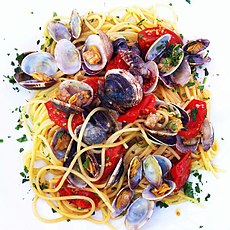 |
| Italian cuisine |
|---|
|
|
Italian cuisine (Template:Lang-it, IPA: [kuˈtʃiːna itaˈljaːna]) has developed through centuries of social and political changes, with roots as far back as the 4th century BC. Italian cuisine in itself takes heavy influences, including Etruscan, ancient Greek, ancient Roman, Byzantine, Jewish and Arab cuisines.[1] Significant changes occurred with the discovery of the New World with the introduction of items such as potatoes, tomatoes, bell peppers and maize, now central to the cuisine but not introduced in quantity until the 18th century.[2][3] Italian cuisine is noted for its regional diversity,[4][5][6] abundance of difference in taste, and is known to be one of the most popular in the world,[7] with influences abroad.[8]
The main characteristics of Italian cuisine is its extreme simplicity, with many dishes having only four to eight ingredients.[9] Italian cooks rely chiefly on the quality of the ingredients rather than on elaborate preparation.[10] Dishes and recipes are often the creation of grandmothers rather than of chefs, and this makes many recipes ideally suited for home cooking. This is one of the main reasons behind the ever increasing popularity of this cuisine, as cooking magazine in foreign countries popularize Italian recipes targeted at the home cook. Ingredients and dishes vary by region. Many dishes that were once regional, however, have proliferated with variations throughout the country. Cheese and wine are a major part of the cuisine, with many variations and Denominazione di origine controllata (DOC) (regulated appellation) laws. Coffee, specifically espresso, has become important in Italian cuisine.
History
Italian cuisine has developed over the centuries. Although the country known as Italy did not unite until the 19th century, the cuisine can claim traceable roots as far back as the 4th century BCE. Through the centuries, neighboring regions, conquerors, high-profile chefs, political upheaval and the discovery of the New World have influenced one of the premiere cuisines in the world.
Antiquity

The first known Italian food writer was a Greek Sicilian named Archestratus from Syracuse in the 4th century BCE. He wrote a poem that spoke of using "top quality and seasonal" ingredients. He said that flavors should not be masked by spices, herbs or other seasonings. He placed importance on simple preparation of fish. This style seemed to be forgotten during the 1st century CE when De re coquinaria was published with 470 recipes calling for heavy use of spices and herbs. The Romans employed Greek bakers to produce breads and imported cheeses from Sicily as the Sicilians had a reputation as the best cheese makers. The Romans reared goats for butchering, and grew artichokes and leeks.[11]
Middle Ages
With culinary traditions from Rome and Athens, a cuisine developed in Sicily that some consider the first real Italian cuisine.[citation needed] Arabs invaded Sicily in the 9th century. The Arabs introduced spinach, almonds, rice and perhaps spaghetti.[citation needed] During the 12th century, a Norman king surveyed Sicily and saw people making long strings made from flour and water called atriya, which eventually became trii, a term still used for spaghetti in southern Italy. Normans also introduced casseroles, salt cod (baccalà) and stockfish which remain popular.[12]
Food preservation was either chemical or physical, as refrigeration did not exist. Meats and fish would be smoked, dried or kept on ice. Brine and salt were used to pickle items such as herring, and to cure pork. Root vegetables were preserved in brine after they had been parboiled. Other means of preservation included oil, vinegar or immersing meat in congealed, rendered fat. For preserving fruits, liquor, honey and sugar were used.[13]
The northern Italian regions show a mix of Germanic and Roman culture while the south reflects Arab influence, as much Mediterranean cuisine was spread by Arab trade.[14] The oldest Italian book on cuisine is the 13th century Liber de coquina written in Naples. Dishes include "Roman-style" cabbage (ad usum romanorum), ad usum campanie which were "small leaves" prepared in the "Campanian manner", a bean dish from the Marca di Trevisio, a torta, compositum londardicum which are similar to dishes prepared today. Two other books from the 14th century include recipes for Roman pastello, Lavagna pie, and call for the use of salt from Sardinia or Chioggia.[15]
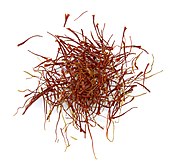
In the 15th century, Maestro Martino was chef to the Patriarch of Aquileia at the Vatican. His Libro de arte coquinaria describes a more refined and elegant cuisine. His book contains a recipe for Maccaroni Siciliani, made by wrapping dough around a thin iron rod to dry in the sun. The macaroni was cooked in capon stock flavored with saffron, showing Arab influence. Of particular note is Martino's avoidance of excessive spices in favor of fresh herbs.[12] The Roman recipes include coppiette and cabbage dishes. His Florentine dishes include eggs with Bolognese torta, Sienese torta and Genoese recipes such as piperata, macaroni, squash, mushrooms, and spinach pie with onions.[16]
Martino's text was included in a 1475 book by Bartolomeo Platina printed in Venice entitled De honesta voluptate et valetudine ("On Honest Pleasure and Good Health"). Platina puts Martino's "Libro" in regional context, writing about perch from Lake Maggiore, sardines from Lake Garda, grayling from Adda, hens from Padua, olives from Bologna and Piceno, turbot from Ravenna, rudd from Lake Trasimeno, carrots from Viterbo, bass from the Tiber, roviglioni and shad from Lake Albano, snails from Rieti, figs from Tuscolo, grapes from Narni, oil from Cassino, oranges from Naples and eels from Campania. Grains from Lombardy and Campania are mentioned as is honey from Sicily and Taranto. Wine from the Ligurian coast, Greco from Tuscany and San Severino and Trebbiano from Tuscany and Piceno are also in the book.[17]
Early modern era
The courts of Florence, Rome, Venice and Ferrara were central to the cuisine. Christoforo Messisbugo, steward to Ippolito d'Este, published Banchetti Composizioni di Vivande in 1549. Messisbugo gives recipes for pies and tarts (containing 124 recipes with various fillings). The work emphasizes the use of Eastern spices and sugar.[18]

In 1570, Bartolomeo Scappi, personal chef to Pope Pius V, wrote his Opera in five volumes, giving a comprehensive view of Italian cooking of that period. It contains over 1,000 recipes, with information on banquets including displays and menus as well as illustrations of kitchen and table utensils. This book differs from most books written for the royal courts in its preference for domestic animals and courtyard birds rather than game. Recipes include lesser cuts of meats such as tongue, head and shoulder. The third volume has recipes for fish in Lent. These fish recipes are simple, including poaching, broiling, grilling and frying after marination. Particular attention is given to seasons and places where fish should be caught. The final volume includes pies, tarts, fritters and a recipe for a sweet Neapolitan pizza (not the current savory version, as tomatoes had not been introduced to Italy. However, such items from the New World as corn (maize) and turkey are included.[19]
In the first decade of the 17th century, Giangiacomo Castelvetro wrote Breve Racconto di Tutte le Radici di Tutte l'Herbe et di Tutti i Frutti (A Brief Account of All Vegetables, Herbs and Fruit), translated into English by Gillian Riley. Originally from Modena, Castelvetro moved to England because he was a Protestant. The book has a list of Italian vegetables and fruits and their preparation. He featured vegetables as a central part of the meal, not just accompaniments. He favored simmering vegetables in salted water and serving them warm or cold with olive oil, salt, fresh ground pepper, lemon juice or verjus or orange juice. He also suggests roasting vegetables wrapped in damp paper over charcoal or embers with a drizzle of olive oil. Castelvetro's book is separated into seasons with hop shoots in the spring and truffles in the winter, detailing the use of pigs in the search for truffles.[19]
In 1662, Bartolomeo Stefani, chef to the Duchy of Mantua, published L'Arte di Ben Cucinare. He was the first to offer a section on vitto ordinario ("ordinary food"). The book described a banquet given by Duke Charles for Queen Christina of Sweden, with details of the food and table settings for each guest, including a knife, fork, spoon, glass, a plate (instead of the bowls more often used) and a napkin. Other books from this time, such as Galatheo by Giovanni della Casa, tell how scalci ("waiters") should manage themselves while serving their guests. Waiters should not scratch their heads or other parts of themselves, or spit, sniff, cough or sneeze while serving diners. The book also told diners not to use their fingers while eating and not to wipe sweat with their napkin.[20]
Modern era

At the beginning of the 18th century, Italian culinary books began to emphasize the regionalism of Italian cuisine rather than French cuisine. Books written then were no longer addressed to professional chefs but to bourgeois housewives.[21] Periodicals in booklet form such as La cuoca cremonese ("The Cook of Cremona") in 1794 give a sequence of ingredients according to season along with chapters on meat, fish and vegetables. As the century progressed these books increased in size, popularity and frequency.[22]

In the 18th century, medical texts warned peasants against eating refined foods as it was believed that these were poor for their digestion and their bodies required heavy meals. It was believed by some that peasants ate poorly because they preferred eating poorly. However, many peasants had to eat rotten food and moldy bread because that was all they could afford.[23]

In 1779, Antonio Nebbia from Macerata in the Marche region, wrote Il Cuoco Maceratese ("The Cook of Macerata"). Nebbia addressed the importance of local vegetables and pasta, rice and gnocchi. For stock, he preferred vegetables and chicken over meat. In 1773, the Neopolitan Vincenzo Corrado's Il Cuoco Galante ("The Courteous Cook") gave particular emphasis to Vitto Pitagorico (vegetarian food). "Pitagoric food consists of fresh herbs, roots, flowers, fruits, seeds and all that is produced in the earth for our nourishment. It is so called because Pythagoras, as is well known, only used such produce. There is no doubt that this kind of food appears to be more natural to man, and the use of meat is noxious." This book was the first to give the tomato a central role with thirteen recipes. Zuppa alli Pomidoro in Corrado's book is a dish similar to today's Tuscan Pappa al Pomodoro. Corrado's 1798 edition introduced a "Treatise on the Potato" after the French Antoine-Augustin Parmentier's successful promotion of it.[24] In 1790, Francesco Leonardi in his book L'Apicio moderno ("Modern Apicius") sketches a history of the Italian Cuisine from the Roman Age and gives as first a recipe of a tomato based sauce.[25]
In the 19th century, Giovanni Vialardi, chef to King Victor Emmanuel, wrote A Treatise of Modern Cookery and Patisserie with recipes "suitable for a modest household." Many of his recipes are for regional dishes from Turin including twelve for potatoes such as Genoese Cappon Magro. In 1829, Il Nuovo Cuoco Milanese Economico by Giovanni Felice Luraschi features Milanese dishes such as Kidney with Anchovies and Lemon and Gnocchi alla Romana. Gian Battista and Giovanni Ratto's La Cucina Genovese in 1871 addressed the cuisine of Liguria. This book contained the first recipe for pesto. La Cucina Teorico-Pratica written by Ippolito Cavalcanti has the first recipe for pasta with tomatoes.[26] La scienza in cucina e l'arte di mangiare bene ("The Science of Cooking and the Art of Eating Well"), by Pellegrino Artusi, first published in 1891, is widely regarded as the canon of classic modern Italian cuisine, and it is still in print. Its recipes come mainly from Romagna and Tuscany, where he lived.
Ingredients



Italian cuisine has a great variety of different ingredients which are commonly used, ranging from fruits, vegetables, sauces, meats, etc. In the North of Italy, fish (such as cod, or baccalà), potatoes, rice, maize, corn, sausages, pork, and different types of cheeses are the most common ingredients. Ligurian ingredients are quite different, and include several types of fish and seafood dishes; basil (found in pesto), nuts and olive oil are very common. In Emilia-Romagna, common ingredients include ham (prosciutto), sausage (cotechino), different sorts of salami, truffles, grana, Parmigiano-Reggiano, and tomatoes (Bolognese sauce or ragù). Traditional Central Italian cuisine uses ingredients such as tomatoes, all kinds of meat (except for horse meat), fish, and pecorino cheese. Finally, in Southern Italy, tomatoes – fresh or cooked into tomato sauce – peppers, olives and olive oil, garlic, artichokes, oranges, ricotta cheese, eggplants, zucchini, certain types of fish (anchovies, sardines and tuna), and capers are important components to the local cuisine.
Italian cuisine is also well known (and well regarded) for its use of a diverse variety of pasta. Pasta include noodles in various lengths, widths and shapes. Distinguished on shapes they are named — penne, maccheroni, spaghetti, linguine, fusilli, lasagne and many more varieties that are filled with other ingredients like ravioli and tortellini. The word pasta is also used to refer to dishes in which pasta products are a primary ingredient. It is usually served with sauce. There are hundreds of different shapes of pasta with at least locally recognized names. Examples include spaghetti (thin rods), rigatoni (tubes or cylinders), fusilli (swirls), and lasagne (sheets). Dumplings, like gnocchi (made with potatoes) and noodles like spätzle, are sometimes considered pasta. They are both traditional in parts of Italy.
Pasta is categorized in two basic styles: dried and fresh. Dried pasta made without eggs can be stored for up to two years under ideal conditions, while fresh pasta will keep for a couple of days in the refrigerator. Pasta is generally cooked by boiling. Under Italian law, dry pasta (pasta secca) can only be made from durum wheat flour or durum wheat semolina, and is more commonly used in Southern Italy compared to their Northern counterparts, who traditionally prefer the fresh egg variety. Durum flour and durum semolina have a yellow tinge in color. Italian pasta is traditionally cooked al dente (Italian: "firm to the bite", meaning not too soft). Outside Italy, dry pasta is frequently made from other types of flour (such as wheat flour), but this yields a softer product that cannot be cooked al dente. There are many types of wheat flour with varying gluten and protein depending on variety of grain used.
Particular varieties of pasta may also use other grains and milling methods to make the flour, as specified by law. Some pasta varieties, such as pizzoccheri, are made from buckwheat flour. Fresh pasta may include eggs (pasta all'uovo 'egg pasta'). Whole wheat pasta has become increasingly popular because of its health benefits over pasta made from bleached flour.
Regional cuisines
Each area has its own specialties, primarily at regional level, but also at provincial level. The differences can come from a bordering country (such as France or Austria), whether a region is close to the sea or the mountains, and economics. Italian cuisine is also seasonal with priority placed on the use of fresh produce.[citation needed]
Friuli-Venezia Giulia
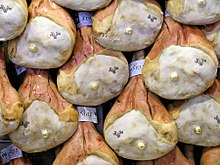
Friuli-Venezia Giulia conserved, in its cuisine, the historical links with Austria-Hungary. Carnia subregion, in the western part of Friuli, is known for its traditional San Daniele del Friuli ham, Montasio cheese, Frico cheese. Other typical dishes are pitina (meatballs made of smoked meats), game, and various types of gnocchi and polenta. The majority of the eastern regional dishes are heavily influenced by Austrian, Hungarian, Slovene and Croatian cuisines: typical dishes include Istrian Stew (soup of beans, sauerkraut, potatoes, bacon and spare ribs), Vienna sausages, goulash, ćevapi, apple strudel, gugelhupf. Pork can be spicy and is often prepared over an open hearth called a fogolar. Collio Goriziano, Friuli Isonzo, Colli Orientali del Friuli and Ramandolo are well-known DOC regional wines.
Veneto
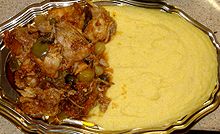

Venice and many surrounding parts of Veneto are known for risotto, a dish whose ingredients can highly vary upon different areas, as fish and seafood being added closer to the coast and pumpkin, asparagus, radicchio and frogs' legs appearing further away from the Adriatic. Made from finely ground maize meal, polenta is a traditional, rural food typical of Veneto and most of Northern Italy. It may find its way into stirred dishes and baked dishes and can be served with various cheese, stockfish or meat dishes: some polenta dishes includes porcini, rapini, or other vegetables or meats, such as small song-birds in the case of the Venetian and Lombard dish polenta e osei, or sausages. In some areas of Veneto it can be also made of a particular variety of cornmeal, named biancoperla, so that the colour of polenta is white and not yellow (the so-called polenta bianca). Beans, peas and other legumes are seen in these areas with pasta e fagioli (beans and pasta) and risi e bisi (rice and peas). Veneto features heavy dishes using exotic spices and sauces. Ingredients such as stockfish or simple marinated anchovies are found here as well. Less fish and more meat is eaten away from the coast. Other typical products are sausages such as Soppressa Vicentina, garlic salami and Asiago cheese. High quality vegetables are prized, such as red radicchio from Treviso and white asparagus from Bassano del Grappa. Perhaps the most popular dish of Venice is fegato alla veneziana, thinly-sliced veal liver sauteed with onions.

Squid and cuttlefish are common ingredients, as is squid ink, called nero di seppia.[27][28] Regional desserts include tiramisu (made of biscuits dipped in coffee, layered with a whipped mixture of egg yolks and mascarpone, and flavored with liquor and cocoa[29]), baicoli (biscuits made with butter and vanilla) and nougat.
The most celebrated Veneto wines include Bardolino, Prosecco, Soave and Valpolicella DOC wines.
Trentino-Alto Adige/South Tyrol
Before the Council of Trent in the middle of the 16th century, the region was known for the simplicity of its peasant cuisine. When the prelates of the Catholic Church established there, they brought the art of fine cooking with them. Later, also influences from Venice and the Austrian Habsburg Empire came in. Trentino subregion produces various types of sausages, polenta, yogurt, cheese, potato cake, funnel cake and freshwater fish. In the South Tyrol subregion, due to the German speaking majority population, strong Austrian and Slavic influences prevail. The most renowned local product is traditional speck juniper-flavored ham which, as Speck Alto Adige PGI, is regulated by the European Union under the protected geographical indication (PGI) status. Goulash, knödel, apple strudel, kaiserschmarrn, krapfen, rösti, spätzle and rye bread are regular dishes, along with potatoes, dumpling, homemade sauerkraut, and lard.[30] The territory of Bolzano is also reputed for its Müller-Thurgau white wines.
Lombardy
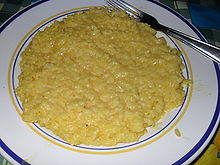

The regional cuisine of Lombardy is heavily based upon ingredients like maize, rice, beef, pork, butter, and lard. Rice dishes are very popular in this region, often found in soups as well as risotto. The best known version is risotto alla milanese, flavoured with saffron and typically served with many typical Milanese main courses, such as ossobuco alla milanese (cross-cut veal shanks braised with vegetables, white wine and broth) and cotoletta alla milanese (a fried cutlet similar to Wiener schnitzel, but cooked "bone-in"). Other regional specialities include cassoeula (a typical winter dish prepared with cabbage and pork), Cremona's Mostarda (rich condiment made with candied fruit and a mustard flavoured syrup), Valtellina's Bresaola (air-dried salted beef) and Pizzoccheri (a flat ribbon pasta, made with 80% buckwheat flour and 20% wheat flour cooked along with greens, cubed potatoes and layered with pieces of Valtellina Casera cheese) and Mantua's tortelli di zucca (ravioli with pumpkin filling) accompanied by melted butter and followed by turkey stuffed with chicken or other stewed meats.[31] Regional cheeses include Robiola, Crescenza, Taleggio, Gorgonzola and Grana Padano (the plains of central and southern Lombardy allow intensive cattle-raising). Polenta is generally common across the region. Regional desserts include the famous panettone Christmas cake (sweet bread with candied orange, citron, and lemon zest, as well as raisins, which are added dry and not soaked).
Valle d'Aosta

Bread thickened soups are customary as well as cheese fondue, chestnuts, potatoes, rice. Polenta is a staple along with rye bread, smoked bacon and game from the mountains and forests. Butter and cream are important in stewed, roasted and braised dishes.[32] Typical regional products include Fontina cheese, Vallée d'Aoste Lard d'Arnad and Génépi Artemisia-based liqueur.
Piedmont
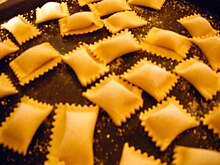
Nestled between the Alps and the Po valley, with a large number of different ecosystems, this region offers the most refined and varied cuisine of the Italian peninsula. Point of union of traditional Italian and French cuisine, Piedmont is the Italian region with the largest number of cheeses Protected Geographical Status and wines Denominazione di origine controllata. It is also the region where both Slow Food association and the most prestigious school of Italian cooking, the University of Gastronomic Sciences, were founded.

Piedmont is a region where gathering nuts, funghi, cardoons and hunting and fishing takes place. Truffles, garlic, seasonal vegetables, cheese and rice are all used. Wines from the Nebbiolo grape such as Barolo and Barbaresco are produced as well as wines from the Barbera grape, fine sparkling wines, and the sweet, lightly sparkling, Moscato d'Asti. The region is also famous for its Vermouth and Ratafia production. Castelmagno is a prized cheese of the region. Piedmont is also famous for the quality of its Carrù beef, hence the tradition of eating raw meat seasoned with garlic oil, lemon and salt, the famous Brasato al vino, wine stew made from marinated beef, and boiled beef served with various sauces. The most typical of the Piedmont tradition are its traditional agnolotti (pasta folded over with a roast beef meat and vegetable stuffing), bagna cauda (sauce of garlic, anchovies, olive oil and butter) and bicerin (hot drink made of coffee, chocolate and whole milk). Finally Piedmont is one of the Italian capitals of pastry and chocolate in particular, with products like Nutella, gianduiotto and marron glacé that are famous worldwide.[33]
Liguria

Herbs and vegetables (as well as seafood) find their way into the cuisine. Savory pies are popular, mixing greens and artichokes along with cheeses, milk curds and eggs. Onions and olive oil are used. Because of a lack of land suitable for wheat, the Ligurians use chick-peas in farinata and polenta-like panissa. The former is served plain or topped with onions, artichokes, sausage, cheese or young anchovies. Hilly districts use chestnuts as a source of carbohydrates. Ligurian pastas include corzetti from the Polcevera valley, pansoti, a triangular shaped ravioli filled with vegetables, piccagge, pasta ribbons made with a small amount of egg and served with artichoke sauce or pesto sauce, trenette, made from whole wheat flour cut into long strips and served with pesto, boiled beans and potatoes, and trofie, a Ligurian gnocchi made from whole grain flour and boiled potatoes, made into a spiral shape and often tossed in pesto.[34] Many Ligurians emigrated to Argentina in the late 19th and early 20th centuries, influencing the cuisine of this country (which otherwise dominated by meat and dairy produces which the narrow ligurian hinterland would have not allowed).
Emilia-Romagna
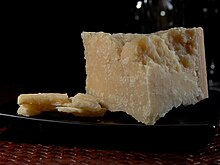
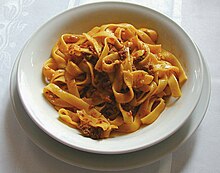
Emilia-Romagna is known for its egg and filled pasta made with soft wheat flour. Bologna is notable for pasta dishes like tortellini, lasagne, gramigna and tagliatelle which are found also in many other parts of the region in different declinations. Romagna subregion is known as well for pasta dishes like cappelletti, garganelli, strozzapreti, spoglia lorda and tortelli alla lastra. In Emilia subregion, except Piacenza which is heavily influenced by the cuisines of Lombardy, rice is eaten to a lesser extent. Polenta, a maize-based dish, is common both in Emilia and Romagna. The celebrated balsamic vinegar is made only in the Emilian cities of Modena and Reggio Emilia, following legally binding traditional procedures.[35] Parmigiano Reggiano cheese is produced in Reggio Emilia, Parma, Modena and Bologna and is much used in cooking, whilst Grana Padano variety is produced in Piacenza. Although the Adriatic coast is a major fishing area (well-known for its eels and clams), the region is more famous for its meat products, especially pork-based, that include: Parma's culatello and Felino salami, Piacenza's pancetta, coppa and salami, Bologna's mortadella and salame rosa, Modena's zampone, cotechino and cappello di prete and Ferrara's salama da sugo. Piacenza and Ferrara are also known for some dishes prepared with horse and donkey meat. Regional desserts include zuppa inglese (custard-based dessert made with sponge cake and Alchermes liqueur) and pampepato (Christmas cake made with pepper, chocolate, spices, and almonds). An exhaustive list of the most important regional wines should include Sangiovese, Lambrusco, Cagnina di Romagna, Colli Piacentini, Trebbiano.
Tuscany

Simplicity is central to the Tuscan cuisine. Legumes, bread, cheese, vegetables, mushrooms and fresh fruit are used. A good example would be ribollita, a notable Tuscan soup whose name literally means "reboiled". Like most Tuscan cuisine, the soup has peasant origins. It was originally made by reheating (i.e. reboiling) the leftover minestrone or vegetable soup from the previous day. There are many variations but the main ingredients always include leftover bread, cannellini beans and inexpensive vegetables such as carrot, cabbage, beans, silverbeet, cavolo nero (Tuscan kale), onion and olive oil. A regional Tuscan pasta known as pici resembles thick, grainy-surfaced spaghetti, and is often rolled by hand. White truffles from San Miniato appear in October and November. High-quality beef, used for the traditional Florentine steak, come from the Chianina cattle breed of the Chiana Valley and the Maremmana from Maremma. Pork is also produced.[36] The region is well-known also for its rich game, especially wild boars, hares, fallow deers, roe deers and pheasant that often are used to prepare pappardelle dishes. Regional desserts include panforte (prepared with honey, fruits and nuts), ricciarelli (biscuits made using an almond base with sugar, honey and egg white), and cavallucci (cookies made with almonds, candied fruits, coriander, flour, honey). Well-known regional wines include Brunello di Montalcino, Carmignano, Chianti, Morellino di Scansano, Parrina, Sassicaia, Vernaccia di San Gimignano.
Umbria
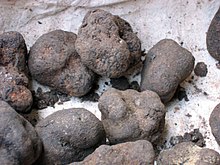
Many Umbrian dishes are prepared by boiling or roasting with local olive oil and herbs. Vegetable dishes are popular in the spring and summer, while fall and winter sees meat from hunting and black truffles from Norcia. Meat dishes include the traditional wild boar sausages, pheasants, geese, pigeons, frogs, snails. Castelluccio is known for its lentils, Spoleto and Monteleone are known for spelt. Freshwater fish include lasca, trout, freshwater perch, grayling, eel, barbel, whitefish, and tench.[37] Orvieto and Sagrantino di Montefalco are important regional wines.
Marche
On the coast of Marche, fish and seafood are produced. Inland, wild and domestic pigs are used for sausages and hams. These hams are not thinly sliced, but cut into bite-sized chunks. Suckling pig, chicken and fish are often stuffed before being roasted or placed on the spit.[38] Ascoli, Marche southernmost province, is well-know for Olive all'ascolana, (stoned olives stuffed with several meats and parmesan, then fried).
Lazio
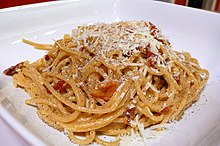
Pasta dishes based on the use of guanciale (unsmoked bacon prepared with pig's jowl or cheeks) are often found in Lazio, such as pasta alla carbonara, and the spicy pastas all'amatriciana. Another spicy pasta dish of the region is arrabbiata. The regional cuisine widely use offal, resulting in dishes like the entrail-based rigatoni with pajata sauce and coda alla vaccinara. Iconic of Lazio are also cheese made from ewes'milk (Pecorino Romano), porchetta (savory, fatty, and moist boneless pork roast) and Frascati white wine. The influence of the ancient Jewish community can be noticed in the Roman cuisine's traditional carciofi alla giudia.[39]
Abruzzo and Molise
Pasta, meat and vegetables are central to the cuisine of Abruzzo and Molise. Chilies (peperoncini) are typical of Abruzzo, where they are called diavoletti ("little devils") for their spicy heat. Centerbe ("Hundred Herbs") is a strong (72% alcohol), spicy herbal liqueur drunk by the locals. Lamb is used with pasta. A dish from Pescara is arrosticini, little pieces of castrated lamb on a wooden stick and cooked on coals. The chitarra (literally "guitar") is a fine stringed tool that pasta dough is pressed through for cutting. The popularity of saffron, grown in the province of L'Aquila, has waned in recent years.[40] Montepulciano d'Abruzzo is an important local red wine. The most famous dish of Molise is cavatelli, a long shaped, handmade maccheroni-type pasta made of flour, semolina and water, often served with meat sauce, broccoli or mushrooms.
Campania
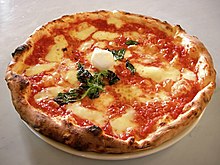
Campania extensively produces tomatoes, peppers, spring onions, potatoes, artichokes, fennel, lemons and oranges which all take on the flavor of volcanic soil. The Gulf of Naples offers fish and seafood. Campania is one of the largest producers and consumers of pasta in Italy, especially spaghetti. In the regional cuisine, pasta is prepared in various styles that can feature tomato sauce, cheese, clams and shellfish. Spaghetti alla puttanesca is a popular dish made with olives, tomatoes, anchovies, capers, chili peppers and garlic. The region is well-known for also its mozzarella production (especially from the milk of water buffalo) that's used in a variety of dishes, including parmigiana (shallow fried eggplant slices layered with cheese and tomato sauce, then baked). Desserts include struffoli (deep fried balls of dough) ricotta-based pastiera and sfogliatelle, and rum-dipped babà.[41]
Originating in Neapolitan cuisine, pizza has become popular in many different parts of the world.[42] Pizza is an oven-baked, flat, disc-shaped bread typically topped with a tomato sauce, cheese (usually mozzarella) and various toppings depending on the culture. Since the original pizza, several other types of pizzas have evolved.
Since Naples was the capital of the Kingdom of Two Sicilies, its cuisine took much from the culinary traditions of all the Campania region, reaching a balance between dishes based on rural ingredients (pasta, vegetables, cheese) and seafood dishes (fish, crustaceans, mollusks). A vast variety of recipes is influenced by the local aristocratic cuisine, like timballo and the sartù di riso, pasta or rice dishes with very elaborate preparation, while the dishes coming from the popular traditions contain poor but nutritionally healthy ingredients, like pasta with beans and other pasta dishes with vegetables.
Famous regional wines are Greco di Tufo and Taurasi.
Puglia
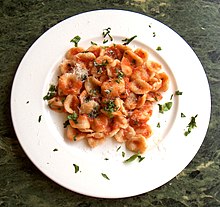
Puglia is a massive food producer: major production includes wheat, tomatoes, zucchini, broccoli, bell peppers, potatoes, spinach, eggplants, cauliflower, fennel, endive, chickpeas, lentils, beans and cheese (like the traditional caciocavallo cheese). Apulia is also the largest producer of olive oil in Italy. The sea offers abundant fish and seafood that are extensively used in the regional cuisine, especially oysters, and mussels. Goat and lamb are occasionally used.[43] The region is known for pasta made from durum wheat and traditional pasta dishes featuring orecchiette-type pasta, often served with tomato sauce, potatoes, mussels or broccoli. Regional desserts include zeppola, doughnuts usually topped with powdered sugar and filled with custard, jelly, cannoli-style pastry cream or a butter-and-honey mixture.y For Christmas, Pugliesi make a very traditional rose shape pastry called Cartellate. These are fried and dipped in Vin Cotto which is a reduction of wine or in some cases of fig juice.
Basilicata
Pork is an integral part of Basilicata's cuisine, often made into sausages or roasted on a spit. Mutton and lamb are also popular. Pasta sauces are generally based on meats or vegetables. Spicy peperoncini are much used. The bitter digestif Amaro Lucano is made here.[44]
Calabria
The cuisine of Calabria has been influenced by conquerors and visitors. The Arabs brought oranges, lemons, raisins, artichokes and egg plants. Cistercian monks introduced new agricultural practices to the region along with dairy products. French rule under the House of Anjou and Napoleon, along with Spanish influence, affected the language and culinary skills as seen in the naming of things such as cake, gatò, from the French gateau. Seafood includes swordfish, shrimp, lobster, sea urchin and squid. Macaroni-type pasta is widely used in regional dishes, often served with goat, beef or pork sauce and salty ricotta.[45] Main courses include Frìttuli (prepared by boiling pork rind, meat and trimmings in pork fat), different varieties of spicy sausages (like Nduja and Capicola), goat and land snails. Melon and watermelon are traditionally served in a chilled fruit salad or wrapped in ham.[46] Calabrian wines include Greco di Bianco, Bivongi, Cirò, Dominici, Lamezia, Melissa, Pollino, Sant'Anna di Isola Capo Rizzuto, San Vito di Luzzi, Savuto, Scavigna, Verbicaro.
Sicily


Sicily shows traces of all the cultures which established themselves on the island over the last two millennia. Although its cuisine undoubtably has a predominantly Italian base, Sicilian food also has Spanish, Greek and Arab influences. Dionysus is said to have introduced wine to the region: a trace of historical influence from Ancient Greece. The ancient Romans introduced lavish dishes based on goose. The Byzantines favored sweet and sour flavors and the Arabs brought, sugar, citrus, sweet melons, rice, saffron, nutmeg, clove, black pepper, and cinnamon. The Normans and Hohenstaufens had a fondness for meat dishes. The Spanish introduced items from the New World including chocolate, maize, turkey and tomatoes.[47]
Much of the island's cuisine encourages the use of fresh vegetables such as eggplant, peppers, and tomatoes, and fish such as tuna, sea bream, sea bass, cuttlefish, and swordfish. In Trapani, in the extreme western corner of the island, North African influences are clear in the use of various couscous based dishes, usually combined with fish. Traditional specialties from Sicily include arancini (a form of deep-fried rice croquettes), pasta alla Norma, caponata, pani ca meusa, and a host of desserts and sweets such as cannoli, granita, and cassata).
Typical of Sicily is Marsala, a red, fortified wine similar to Port and largely exported.
Sardinia


Rock lobster, scampi, squid, tuna, sardines and other seafood figure prominently. Suckling pig and wild boar are roasted on the spit or boiled in stews of beans and vegetables, thickened with bread. Herbs such as mint and myrtle are widely used in the regional cuisine. Sardinia have also many special types of bread, made dry, which keeps longer than high-moisture breads. Those are baked as well, including carasau bread civraxiu, coccoi pinatus, a highly decorative bread and pistoccu made with flour and water only, originally meant for herders, but often served at home with tomatoes, basil, oregano, garlic and a strong cheese.[48]
Meal structure
Traditionally, meals in Italy usually contain 3 or 4 courses. Meals are seen as a time to spend with family and friends instead of immediate sustenance; thus, daily meals can be longer than in other cultures. During holidays, family feasts can last for hours.
Today, the traditional Italian menu is kept mainly for special events (such as weddings) while an everyday menu includes only the first and second course, the side dish and coffee. A notable aspect of Italian meals is that the primo or first course, is usually a more filling dish such as risotto or pasta. Modern Italian cuisine also includes single courses (all-in-one courses), providing carbohydrates and proteins at the same time (e.g. pasta and legumes).

| Meal stage | Composition |
|---|---|
| Aperitivo | apéritif usually enjoyed as an appetizer before a large meal, may be: Campari, Cinzano, Prosecco, Aperol, Spritz, Vermouth. |
| Antipasto | literally "before (the) meal", hot or cold appetizers |
| Primo | "first course", usually consists of a hot dish like pasta, risotto, gnocchi, or soup. |
| Secondo | "second course", the main dish, usually fish or meat. Traditionally veal, pork and chicken are most commonly used, at least in the North, though beef has become more popular since World War II and wild game is found, particularly in Tuscany. Fish are generally caught locally. |
| Contorno | "side dish", may be a salad or cooked vegetables. A traditional menu features salad along with the main course. |
| Formaggio e frutta | "cheese and fruits", the first dessert. Local cheeses may be part of the Antipasto or Contorno as well. |
| Dolce | "sweet", such as cakes and cookies |
| Caffè | coffee |
| Digestivo | "digestives", liquors/liqueurs (grappa, amaro, limoncello, sambuca, nocino, sometimes referred to as ammazzacaffè ("coffee killer") |
Note: On restaurant menus, these terms may be referred to as Primi, Secondi, Contorni, and Digestivi.
Food establishments

Each type of establishment has a defined role and traditionally sticks to it.[49]
| Establishment | Description |
|---|---|
| Agriturismo | Working farms that offer accommodations and meals. Often the meals are served to guests only. Marked by a green and gold sign with a knife and fork.[50] |
| Bar/Caffé | Locations which serve coffee, soft drinks, juice and alcohol. Hours are generally from 6am to 10pm. Foods may include brioche, panini, tramezzini (sandwiches) and spuntini (snacks such as olives, potato crisps and small pieces of frittata).[50] |
| Birreria | A bar that offers beer found in central and northern regions of Italy.[50] |
| Frasca/Locanda | Friulian wine producers that open for the evening and may offer food along with their wines.[50] |
| Gelateria | An Italian ice cream shop/bar, that sells gelato. A shop where you can get your gelato to go, or sit down and eat it in a cup or a cone. You can also order bigger ice desserts, or coffee and liquors. |
| Osteria | Focused on simple food of the region, often having only a verbal or daily menu. Many are open only at night but some open for lunch.[51] |
| Paninoteca | Sandwich shop open during the day.[51] |
| Pizzeria | Locations specializing in Pizza. Wood fired-pizza ovens are a specialty of Italy.[52] Pizza is traditionally eaten only for dinner and foregoes the traditional meal structure. |
| Polenteria | A regional establishment seen in limited number north of Emilia-Romagna.[53] |
| Ristorante | Often offers upscale cuisine and printed menus.[52] |
| Spaghetteria | Originating in Napoli, offering pasta dishes and other main courses.[54] |
| Tavola Calda | Literally "hot table", offers pre-made regional dishes. Most open at 11am and close late.[55] |
| Trattoria | A dining establishment often family run with inexpensive prices and an informal atmosphere.[56] |
Drinks
Coffee


Italian style coffee (caffè), also known as espresso is made from a blend of coffee beans, often from Brazil. Espresso beans are roasted medium to medium dark in the north, and gets darker moving south.
A common misconception is that espresso has more caffeine than other coffee but the opposite is true. The longer roasting period extracts more caffeine. The modern espresso machine, invented in 1937 by Achille Gaggia, uses a pump and pressure system with water heated to 90 to 95 °C (194 to 203 °F) and forced with high pressure through a few grams of finely ground coffee in 25–30 seconds, resulting in about 25 milliliters (0.85 fl oz, two tablespoons) of liquid.[57]
Home espresso makers are simpler but work under the same principle. La Napoletana is a four part stove-top unit with grounds loosely placed inside a filter, the kettle portion is filled with water and once boiling, the unit is inverted to drip through the grounds. The Moka per il caffè is a three part stove-top unit that is placed on the stove-top with loosely packed grounds in a strainer, the water rises from steam pressure, and is forced through the grounds into the top portion. It is unlike a percolator in that the brewed coffee is not re-circulated.[58]
Espresso is usually served in a demitasse cup. Caffè macchiato is topped with a bit of steamed milk or foam; ristretto is made with less water, and is stronger; cappuccino is mixed or topped with steamed, mostly frothy, milk. It is generally considered a morning beverage; caffelatte is equal parts espresso and steamed milk, similar to café au lait, and is typically served in a large cup. Latte macchiato (spotted milk) is a glass of warm milk with a bit of coffee and Caffè corretto is "corrected" with a few drops of an alcoholic beverage.
The Bicerin is also an Italian coffee, from Turin. It is a mixture of cappucino and traditional hot chocolate, as it consists of a mix of coffee and drinking chocolate, and with a small addition of milk. It is quite thick, and often whipped cream/foam with chocolate powder and sugar is added on top.
Alcoholic beverages
Wine
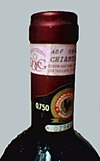



Italy produces the largest amount of wine in the world and is both the largest exporter and consumer of wine. Only about a quarter of this wine is put into bottles for individual sale. Two-thirds is bulk wine used for blending in France and Germany. The wine distilled into spirits in Italy exceeds the production of wine in the entirety of the New World.[59] There are twenty separate wine regions.[60]
Those vineyards producing great wines are trying to do away with the old image of jug wines so often associated with Italian wine. To promote this, the Italian government passed the Denominazione di origine controllata (DOC) law in 1963 to regulate place of origin, quality, production method and type of grape. The designation Indicazione Geografica Tipica (IGT) is a less restrictive designation to help a wine maker graduate to the DOC level. In 1980, the government created the Denominazione di origine controllata e garantita (DOCG), reserved for only the best wines.[61]
Beer
Italy hosts a wide variety of different beers, which are usually pale lager. Beer is not as popular and widespread as wine (even though this is changing, and beer is becoming more and more popular), and the average beer consumption in Italy is less than in some other neighbouring European nations, such as the United Kingdom, Germany and Austria. The most notable Italian breweries are Peroni and Moretti, even though there are several other popular ones. Beer in Italy is often drunk in pizzerias, and South Tyrol (former part of Austria, country notable for its beer) is the area where beer is made and consumed the most.
Other
There are also several other popular alcoholic drinks in Italy. Limoncello, a traditional lemon liqueur from Sicily and Southern Italy (Sorrento, Amalfi and the Gulf of Naples) in general, is one of the most common. Made out of lemon, it is extremely strong drink which is usually consumed in very small proportions, in small glasses or cups. Amaro Sicilianos are common Sicilian digestifs made out of herbs which are usually drunk after heavy meals. Grappa instead is the typical alcoholic drink of northern Italy, general associated with the culture of the Alps and of the Po Valley. The most famous grappas are distilled in Friuli-Venezia Giulia, Veneto, Piedmont and Trentino. The three most notable and recognizable Italian aperitifs are Martini, Vermouth and Campari. A sparkling drink which is becoming internationally popular as a less expensive substitute of French champagne is prosecco, from the Veneto region.[62][63]
Holiday cuisine
Every region has its own holiday recipes. During La Festa di San Giuseppe (St. Joseph's Day) on March 19, Sicilians give thanks to St. Joseph for preventing a famine during the Middle Ages. The fava bean saved the population from starvation, and is a traditional part of St. Joseph's Day altars and traditions. Other customs celebrating this festival include wearing red clothing, eating Sicilian pastries known as zeppole and giving food to the poor.
On Easter Sunday, lamb is served in throughout Italy. A typical Easter Sunday breakfast in Umbria and Tuscany includes salami, boiled eggs, wine, Easter Cakes and pizza. The common cake for Easter Day is the Colomba Pasquale (literally, Easter dove), which is often simply known as "Italian Easter cake" abroad. It s supposed to represent the dove, and is topped with almonds and pearl sugar.
On Christmas Eve a symbolic fast is observed with the cena di magro ("light dinner"), a meatless meal. On Christmas day, Italians often serve tortellini as a first course. Typical cakes of the Christmas season are panettone and pandoro.
Meal composition
Breakfast

The first Italian meal is breakfast, or colazione. Traditional Italian breakfasts are continental-style, similar to those of France, Greece or Spain. The traditional breakfast in Italy is simply Caffè e latte (hot coffee with milk) or coffee with bread or rolls, butter, and jam—known as prima colazione or just colazione. Fette biscottate (a cookie-like hard bread often eaten with butter and jam) and biscotti (cookies) are commonly eaten. Children drink hot chocolate, plain milk, or hot milk with very little coffee. If breakfast is eaten in a bar (coffee shop), it is composed of cappuccino e cornetto (frothed hot milk with coffee, and a pastry) or espresso and pastry. Other products such as breakfast cereals, fruit compote (Macedonia), muesli and yogurt are becoming increasingly common as part of the meal. It is very common for some Italians, mainly from the Central and Southern regions, to have a quick breakfast snack during the morning (typically a panino, or bread roll). In Sicily, occasionally with feast days or Sundays, people eat ice-cold granita with brioches, or pastries.
Lunch
Pranzo, or lunch used traditionally to be the heartiest and most important Italian meal, although shorter work breaks are significantly changing this lifestyle, especially in the larger urban areas of the North. Lunch is taken in Italy between 12.00 pm and 2.00 pm (usually, people from Southern Italian regions start lunch slightly later, from 1.15 pm to even 2.15 pm). Traditional formal Italian lunches are a lenghty affair, which usually involves an appetizer, aperitif, or antipasto as starter. This usually consists of cold cuts, cheese, bruschette or small sandwiches, olives and sauce dips. This is usually followed by a first course, such as various kinds of pasta, soup, ravioli, or risotto. The main course (secondo, literally "second course") is usually meat or fish, with a vegetable garnish. The meal is rounded up by a dessert, or fresh fruit. Most families still usually tend to have a traditional lunch on Sundays.
Mid-afternoon snack
Most Italians, notably children, have what is called a mid-afternoon snack or in Italian merenda just after school, from about 3.00 pm to 5.00 pm. This can be anything, from fruit, yogurts, ice cream, nuts, brioches, cookies and biscuits, cake, raisins or mousses.
Dinner
The Italian dinner structure is very similar to that of lunch, but Italians tend to have lighter meals at dinner-time. This usually consists of perhaps a salad, soup, risotto or the left-overs of lunch-time. Dinner is called cena in Italian, and is usually consumed later than in Northern Europe and at more or less the same time as Spain and other Mediterranean countries, usually starting from 7.30 pm to 9.30pm.
Italian cuisine abroad
Europe
Great Britain
Pizza and pasta dishes such as spaghetti bolognese and lasagne with bolognese ragù and Béchamel sauce are the most popular forms of Italian food which are popular in British, notably, English, cuisine.
Slovenia
Italian cuisine has had a strong influence on Slovenian cuisine. For centuries, north-eastern Italy and western Slovenia have formed part of the same cultural-historical and geographical space. Between 1918 and 1945, western Slovenia (the Slovenian Littoral and part of Inner Carniola) were part of Italy; in addition, an autochthonous Italian minority live in Slovenian Istria. For all these reasons, Italian dishes have penetrated the local Slovenian cuisine. Furthermore, there are numerous typical dishes that are shared between the Slovenian cuisines and the cuisine of the neighboring Italian region of Friuli Venezia Giulia: these include the gubana nut roll of Friuli (known as guban'ca or potica in Slovenia) and the jota stew.
Among the Slovenian dishes that come directly from Italian cuisine, the gnocchi and some types of pasta are especially popular, as well as dishes like the minestrone (known as mineštra in Slovene) or the frittata (known as frtalja in Slovene).
USA and Canada

Much of Italian-American cuisine is based on that found in Campania and Sicily, heavily Americanized to reflect ingredients and conditions found in the United States. Most pizza eaten around the world derives ultimately from the Neapolitan style, if somewhat thicker and usually with more toppings in terms of quantity.
Central America
Mexico
Throughout the country the "torta milanesa" is a common item offered at food carts and stalls. It is a sandwich made from locally baked bread and contains a breaded, pan-fried cutlet of pork or beef. "Pescado Veracruzano" is a dish that originates from the port city of Veracruz and features a fillet of fresh fish (usually Gulf Red Snapper) covered in a distinctly Mediterranean influenced sauce containing stewed tomatoes, garlic, green olives, and capers. Also, "espagueti" (spaghetti) and other pastas are popular in a variety of soups, especially beloved by children.
South America
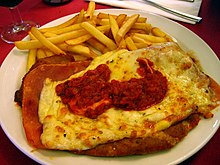
Brazil
Italian cuisine is popular in Brazil, due to great immigration there in the early-1900s. Pizza and similar foods are popular in the cities of São Paulo and Rio de Janeiro.
Argentina
Due to large Italian immigration to Argentina, Italian food and drink is heavily featured in Argentine cuisine. An example could be milanesas (The name comes from the original cotoletta alla milanese from Milan, Italy) or breaded meats. Pizza (locally pronounced pisa or pitsa), for example, has been wholly subsumed and in its Argentine form more closely resembles Italian calzones than it does its Italian ancestor. There are several other Italian-Argentine dishes, such as Sorrentinos and Argentine gnocchi.
Venezuela
There is considerable Italian influence in Venezuelan cuisine. Pan chabata, or Venezuelan ciabatta, Pan Siciliano, Sicilian bread, Cannoli siciliano, Sicilian cannoli, and the drink chinotto are examples of the Italian influence in Venezuelan food and beverages.
Africa
Due to several Italian colonies being set up in Africa, mainly in Ethiopia, Eritrea, Libya and Somalia (except the northern part, which was under British rule), there is a considerable amount of Italian influence on the cuisines of these nations.
Libya
Italy's legacy from the days when Libya was invaded by Italian can be seen in the popularity of pasta on its menus, particularly Sharba is a highly-spiced Libyan soup. Bazin, a local specialty is a hard paste, made from barley, salt and water, and one of the most popular meals in the Libyan cuisine is Batata mubatana (filled potato). It consists of fried potato pieces filled with spiced minced meat and covered with egg and breadcrumbs.
South Africa
All major cities and towns in South Africa have substantial populations of Italians. There are 'Italian Clubs' in all main cities and they have had a significant influence on the cuisine of this country. Italian foods, like ham and cheeses, are imported and some also made locally, and every city has a popular Italian restaurant or two, as well as Pizzerias. Pastas are popular and is eaten more and more by South Africans. The production of good quality olive oil is on the rise in South Africa, especially in the drier south-western parts where there is a more Mediterranean-type of rainfall pattern. Some oils have even won top international awards.
Philippines
Although Italian cuisine is not highly represented in the Philippines, it has made an impression nonetheless. Spaghetti arrive during the time of the American occupation of the country in the early 1900s. It has since evolved into a distinctly Philippine version of the dish. Filipino Spaghetti is characterized by a sauce based on banana ketchup and the presence of sliced hot dogs (sometimes substituted with sausage). It can be found on restaurant menus and is consistently seen at Filipino parties and gatherings. Lasagna is another Italian dish that made its way into Philippine cuisine. Unlike spaghetti, lasagna remains largely unchanged.
See also
- Cuisine of San Marino
- Il cucchiaio d'argento, an Italian cookbook
- Il talismano della felicità by Ada Boni, an Italian cookbook
- Meal structure in Italy
Notes
- ^ "Italian Cooking: History of Food and Cooking in Rome and Lazio Region, Papal Influence, Jewish Influence, The Essence of Roman Italian Cooking". Inmamaskitchen.com. Retrieved 2010-04-24.
- ^ "The Making of Italian Food...From the Beginning". Epicurean.com. Retrieved 2010-04-24.
- ^ Del Conte, 11-21.
- ^ Related Articles (2009-01-02). "Italian cuisine - Britannica Online Encyclopedia". Britannica.com. Retrieved 2010-04-24.
- ^ "Italian Food - Italy's Regional Dishes & Cuisine". Indigoguide.com. Retrieved 2010-04-24.
- ^ "Regional Italian Cuisine". Rusticocooking.com. Retrieved 2010-04-24.
- ^ "Cooking World » The most popular cuisines of the world (Part 1)". Cooking-advices.com. 2007-06-25. Retrieved 2010-04-24.
- ^ Freeman, Nancy (2007-03-02). "American Food, Cuisine". Sallybernstein.com. Retrieved 2010-04-24.
- ^ The Silver Spoon ISBN 88-7212-223-6, 1997 ed.
- ^ Mario Batali Simple Italian Food: Recipes from My Two Villages (1998), ISBN 0-609-60300-0
- ^ Del Conte, 11.
- ^ a b Del Conte, 12.
- ^ Capatti, 253-254.
- ^ Capatti, 2-4.
- ^ Capatti, 6.
- ^ Capatti, 9-10.
- ^ Capatti, 10.
- ^ Del Conte, 13.
- ^ a b Del Conte, 14,15.
- ^ Del Conte, 15.
- ^ De Conte, 16
- ^ Capatti, 158-159.
- ^ Capatti, 282-284.
- ^ De Conte, 17
- ^ Faccioli, 753
- ^ De Conte, 18-19
- ^ Piras, 33.
- ^ "Venice Cuisine - by food author Howard Hillman". Hillmanwonders.com. Archived from the original on June 11, 2008. Retrieved 2010-04-04.
- ^ "history of tiramisu". Retrieved 16 August 2010.
- ^ Piras, 67.
- ^ Piras, 87.
- ^ Piras, 123, 124, 128, 133.
- ^ Davide paolini,Prodotti Tipici D'Italia, Garzanti.
- ^ Piras, 167, 177.
- ^ Piras, 187.
- ^ Piras, 221-239.
- ^ Piras, 255, 256, 260, 261.
- ^ Piras, 273
- ^ Piras, 291.
- ^ Piras, 319.
- ^ Piras, 337.
- ^ Hanna Miller "American Pie," American Heritage, April/May 2006.
- ^ Piras, 361.
- ^ Piras, 383.
- ^ Edward Lear, Diario di un viaggio a piedi - Calabria 1847 - Edizione italiana a cura di Parallelo 38, Reggio Calabria, 1973
- ^ Piras, 401.
- ^ Piras, 423.
- ^ Piras, 457, 460.
- ^ Evans, 198-200.
- ^ a b c d Evans, 200.
- ^ a b Evans, 201.
- ^ a b Evans, 203
- ^ Evans, 203.
- ^ Evans, 204.
- ^ Evans, 205
- ^ Evans, 205.
- ^ Piras, 300.
- ^ Piras, 301.
- ^ Koplan, 301.
- ^ Koplan, 311.
- ^ Koplan, 307-308.
- ^ Atkin, Tim, The Observer (November 11, 2007). "The fizz that's the bizz". The Guardian. London. Retrieved 2008-12-29.
{{cite news}}: CS1 maint: multiple names: authors list (link) - ^ Dane, Ana, TheStreet.com (July 3, 2006). "Pop the Cork on Prosecco". Retrieved 2008-12-29.
{{cite web}}: CS1 maint: multiple names: authors list (link)
References
- Capatti, Alberto and Montanari, Massimo. Italian Cuisine: a Cultural History. New York: Columbia University Press, 2003. ISBN 0-231-12232-2
- Del Conte, Anna. The Concise Gastronomy of Italy. USA: Barnes and Nobles Books, 2004. ISBN 1-86205-662-5
- Dickie, John, Delizia! The Epic History of Italians and Their Food (New York, 2008)
- Evans, Matthew; Cossi, Gabriella; D'Onghia, Peter, World Food Italy. CA: Lonely Planet Publications Pty Ltd, 2000. ISBN 1-86450-022-0
- Faccioli, Emilio. L'Arte della Cucina in Italia. Milano: Einaudi, 1987 (in Italian)
- Koplan, Steven; Smith, Brian H.; Weiss, Michael A.; Exploring Wine, New York: Van Nostrand Reinhold, 1996. ISBN 0-471-35295-0
- Piras, Claudia and Medagliani, Eugenio. Culinaria Italy. Cologne: Könemann Verlagsgesellschaft mbh, 2000. ISBN 3-8290-2901-2
Further reading
- Riley, Gillian (2007) The Oxford Companion to Italian Food. Oxford University Press ISBN 978-0-19-860617-8
- The Italian Academy of Cuisine (Accademia Italiana della Cucina) (2009). La Cucina: The Regional Cooking of Italy. Trans. Jay Hyams. New York: Rizzoli. ISBN 9780847831470. OCLC 303040489. The longest and most extensive Italian cookbook with over 2000 recipes, including background information regarding each recipe.
- Thoms, Ulrike: From Migrant Food to Lifestyle Cooking: The Career of Italian Cuisine in Europe, European History Online, Mainz: Institute of European History, 2011, retrieved: June 22, 2011.
External links
